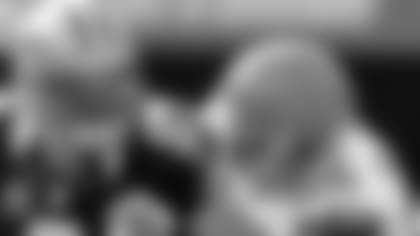IRVING, Texas – It's a big, primetime game for the Cowboys this weekend. So why not have a big preview of their Sunday Night Football opponent, the New Orleans Saints?
This week for our opposing view, I asked John DeShazier, senior writer for NewOrleansSaints.com, to help us preview the opponent. The Saints are coming off their first win of the season, as they downed the Vikings to end a two-game losing streak.* *
1. The Saints' secondary was a team strength in 2013, but it has struggled out of the gate this season. What's been the reason for the dropoff?
Probably, a lot of that has to do with the absence of a consistent pass rush. The Saints produced two sacks in the first two games but, more, didn't apply a lot of pressure. So Atlanta's Matt Ryan and Cleveland's Brian Hoyer were able to get comfortable in the pocket. With a lack of pressure, the two had time to combine for 652
passing yards, four touchdowns and no interceptions and they had time to help Atlanta and Cleveland convert eight times on third-and-6 or longer. Against Minnesota, the pass rush turned up the pressure and the result was different. The Saints produced a couple of sacks but just as critical, forced Matt Cassel and Teddy Bridgewater to be uncomfortable with pressures and contact. So even though New Orleans didn't intercept a pass, Minnesota finished with just 203 passing yards. Admittedly for the Saints, Patrick Robinson, who started at right cornerback the first two games, didn't play well. But when his teammates and coaches say that the team could have done more to help him, that's what they're referring to. Also, the Saints simplified the defensive scheme a bit against Minnesota and went with some defenses they're more familiar with. It allowed the entire defense to play faster.
2. Sean Payton has leaned on multiple running backs throughout his tenure with the Saints, but how did Khiry Robinson and Pierre Thomas fare without Mark Ingram last weekend? And how important is Ingram's return from injury for the offense?
Robinson and Thomas combined for 99 yards on 26 carries against Minnesota. That was OK; obviously, the Saints want to run it better and believe they can run it better (313 rushing yards in the first two games). Robinson and Thomas actually combined for 65 yards on 11 carries in the first half, so the Vikings did a better job of prioritizing the run defensively in the second half. The Saints aren't a team that has to run the ball 30-35 times; quarterback Drew Brees remains the best offensive player, and he has a strong cast of targets (including tight end Jimmy Graham and receivers Marques Colston, Brandin Cooks and Kenny Stills). But they want to run it efficiently, as they did for the first 2½ games. Ingram (143 yards and three touchdowns on 24 carries in the first two games) was off to the best start of his NFL career. He was running more decisively and looked quicker than in the past, though that quicker look may have been a byproduct of his decisiveness. Having him back will give the Saints three running backs that almost are clones in terms of the runs the offense can dial up and blitz pickup (though Thomas remains the superior receiver). So the Saints are anxious for Ingram's break to heal.
3. The Cowboys have struggled to contain every tight end they've faced this season, which doesn't bode well for them with Jimmy Graham coming to town. How have the Saints' three opponents thus far dealt with Graham, and how well has it worked?
Mostly, opponents have tried to bracket Graham – rough him up with a linebacker off the line, play a safety or cornerback over the top. Cleveland tried periodically to match up cornerback Joe Haden, one of the top three in the league at his position, man-to-man and Graham punished Haden and the Browns secondary (10 catches, 118 yards and two touchdowns). Graham will come to Dallas with 24 catches for 254 yards; no one has been able to take him away yet. And with the renewed emphasis on illegal contact in the secondary and defensive holding, Graham probably is even more of a problem for defenses. Put it this way – he can't dunk cross bars any more after touchdowns because of league rules; everything else, he can do better than ever and the rules seem to benefit him.
*In addition, I also answered some questions for the staff over at NewOrleansSaints.com on the Cowboys.
*1. What led to the Morris Claiborne controversy and do you think he might play Sunday night against the Saints?
It's ironic that this controversy arose the week the Saints come to town. Despite the fact that Orlando Scandrick was just promoted to a starting spot, he is one of the best nickelbacks in the league. When the Saints come out in multiple receiver sets, which I'd expect they'll do often, Scandrick will shift inside to the slot. So basically,
despite being demoted, Claiborne is going to play a lot of snaps at cornerback on Sunday night.
As for what led us to this point, Scandrick has simply been the more reliable player between the two. He started 15 games in 2013 and had the best season of his career while Claiborne struggled through injury problems. When Scandrick was suspended for violating the league drug policy this summer, Claiborne was given the starting nod – but it was widely expected the veteran would win his job back when he returned. Claiborne's struggles last weekend in St. Louis accelerated that decision, but it wasn't exactly surprising.
2. Demarco Murray is averaging 25 carries and 128 yards a game. Are the Cowboys now a run-first offense or the passing attack still their calling card?
Before Claiborne left the facility on Tuesday, this was probably the biggest talking point of the season so far. Through three games, Murray is averaging 10 more carries per game than his average in his other 37 games.
This was a theme of the offseason. Having taken offensive linemen in the first round of three of the last four drafts, the talk was about committing to the run game and playing a more physical style of football. Down 21-0 in St. Louis last week, the Cowboys continued to pound the ball with Murray, rather than try to throw their way back into the game – something that would have happened in years past.
The Saints will be a great test for how well this strategy works. The logical assumption is that New Orleans is going to put plenty of points on the board. Can the Cowboys keep up using their ground game, or will they have to hand the reigns to Romo?
3. How did the Cowboys pull off their amazing 21-point comeback against the Rams?
They didn't panic. They had every right to, given how much went wrong for them in the early going of the game. The Rams sold out to stop the run, and the Cowboys were floundering when Romo threw a pick-six to Janoris Jenkins with six minutes left in the first half.
To their credit, the Cowboys didn't change the gameplan. They stuck with Murray and their line, pounding away to the tune of 4.2 yards per carry. That came in handy in the second half, when the focus on the run opened the field up for Romo to hit Dez Bryant for the most wide-open touchdown pass I have ever seen.
Romo was cool under pressure, as well – especially given his early mistake. Having cut the deficit to 24-20, he led the offense on an 11-play, 84-yard yard drive that ate up seven minutes of the fourth quarter. He made perhaps the play of the game on 3rd-and-3 from his own 13 when he scrambled for 16 yards and a first down to preserve the drive. Eight plays later, he hit Terrance Williams for the go-ahead points – again on a crucial third down.
The defense was picked on all day long, but they also managed to keep cool under pressure. The Cowboys intercepted Austin Davis twice in the fourth quarter – the first time for a critical touchdown, and the second time to kill off the Rams' last-gasp scoring drive.
4. What were the major personnel changes the Cowboys made to upgrade their defense or did they just need to get healthy?
It's probably a bit early to say this defense has improved, but the health of the starting lineup has certainly been better so far this year – until recently, at least.
The big difference so far has been the addition of Rolando McClain at middle linebacker. The Cowboys took a chance in trading for the former first-round pick, who has gone through a litany of off-the-field problems in his career. He adds speed, physicality and an undeniable playmaking ability in the middle of the field, as he demonstrated in Week 2 against Tennessee. [embedded_ad]
Unfortunately for Dallas, he missed last week against St. Louis and seems like a longshot for Sunday night, as well.
Another big addition this season has been former Bears Pro Bowler Henry Melton, who has anchored the defensive line for defensive coordinator Rod Marinelli. Melton is off to the best start for the Cowboys' underperforming pass rush with four quarterback hurries and a half-sack. Ironically, Melton might also miss this game with a hamstring injury – a problem the Cowboys are very familiar with.
If there is one bit of good news for the Cowboys this weekend, it's that they might be welcoming another Pro Bowler into the lineup for the first time in nearly two years. Anthony Spencer, who earned a Pro Bowl nod in 2012, is coming back from a microfracture knee surgery that kept him out for virtually all of the 2013 season. He has practiced with the team for the past two weeks, and Cowboys owner/general manager Jerry Jones has said he's hopeful Spencer can go against the Saints.















